
The Masked Marvel (1943) is a 12-chapter film serial created by Republic Pictures, who produced many other well known serials. It was Republic's thirty-first serial, of the sixty-six they produced.

Undersea Kingdom (1936) is a Republic Pictures 12 chapter film serial released in response to Universal's Flash Gordon. It was the second of the sixty-six serials made by Republic. In 1966, the serial was edited into a 100-minute television film titled Sharad of Atlantis.

S O S Coast Guard is a 1937 Republic film serial. It was the seventh of the sixty-six serials made by Republic. The plot concerns the mad scientist Boroff attempting to sell a superweapon to the highest bidder, opposed by Coast Guard Lieutenant Terry Kent, for both personal and professional reasons.
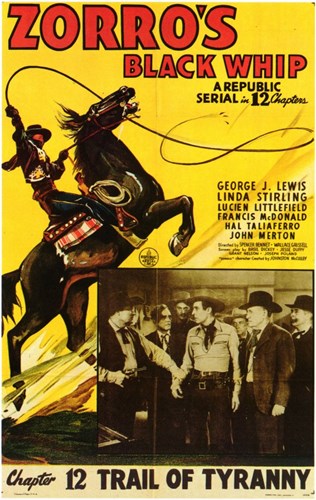
Zorro's Black Whip is a 1944 12-chapter film serial by Republic Pictures starring Linda Stirling. The film was made after the 1940 20th Century-Fox remake of The Mark of Zorro in order to capitalize on it. Republic was not able to use the character of Zorro himself, however, and despite the title, the hero(ine) is called The Black Whip throughout.

The Fighting Devil Dogs (1938) is a 12-chapter Republic movie serial starring Lee Powell and Herman Brix, the latter better known by his later stage name, Bruce Bennett. It was directed by William Witney and John English. While not often considered a great serial, as it contains much stock footage and two recap chapters, it is famous for its main villain, the Lightning—the first costumed supervillain. There is some speculation that George Lucas used the Lightning as a template for Darth Vader.

The Adventures of Red Ryder is a 1940 American 12-chapter movie serial from Republic Pictures, directed by William Witney and John English and starring Don "Red" Barry and Noah Beery, Sr., based on the Western comic strip Red Ryder by Fred Harmon. This serial is the 18th of the 66 serials produced by Republic.

Dick Tracy's G-Men (1939) is a 15-Chapter Republic movie serial based on the Dick Tracy comic strip by Chester Gould. It was directed by William Witney and John English.

Darkest Africa (1936) is a Republic movie serial. This was the first serial produced by Republic Pictures and was a loose sequel to a Mascot Pictures serial called The Lost Jungle, also starring Clyde Beatty. Mascot, and other companies, had been taken over in 1935 by Consolidated Film Laboratories and merged to become Republic. Producer Nat Levine was formerly the owner of Mascot Pictures.
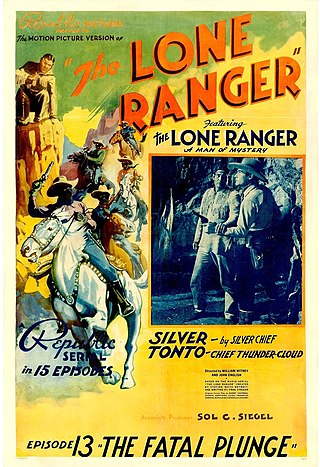
The Lone Ranger is a 1938 American Republic Pictures movie serial based on The Lone Ranger radio program. It was the ninth of the sixty-six serials produced by Republic, the fourth Western and the first Republic serial release of 1938. The following year a sequel serial The Lone Ranger Rides Again was released. The fifteen chapters of the serial were condensed into the film Hi-Yo Silver, which was released in 1940.
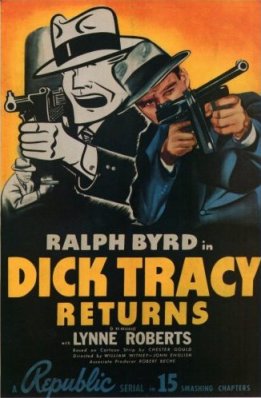
Dick Tracy Returns (1938) is a Republic Movie serial based on the Dick Tracy comic strip. It was the eleventh of the sixty-six serials Republic produced and a sequel to the 1937 serial Dick Tracy, with Ralph Byrd reprising his role as the title character. It was successful enough that two further sequels were released in 1939 and 1941, and Byrd become so connected with the character he went on to play him in a subsequent television series.

Hawk of the Wilderness (1938) is a Republic movie serial based on the Kioga adventure novels written by pulp writer William L. Chester (1907–1971). Kioga was a Tarzanesque white child raised on a lost island in the Arctic Circle, somewhere in northern Siberia, which was heated by thermal springs and unknown currents. Chester wrote four Kioga novels. The first, Hawk of the Wilderness (1935), was the one that was filmed as the 12-part 1938 Republic serial. (The other novels in the series were Kioga of the Wilderness, One Against a Wilderness and Kioga of the Unknown Land.

Dick Tracy vs. Crime, Inc. (1941) is a Republic Movie serial based on the Dick Tracy comic strip. It was directed by the team of William Witney and John English with Ralph Byrd reprising his role from the earlier serials. It was the last of the four Dick Tracy serials produced by Republic, although Ralph Byrd went on to portray the character again in two features and on television.
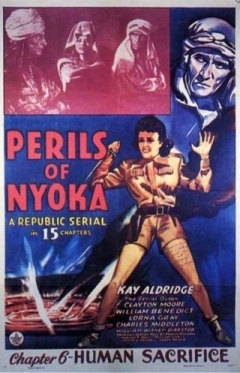
Perils of Nyoka is a 1942 Republic serial directed by William Witney. It stars Kay Aldridge as Nyoka the Jungle Girl, a character who first appeared in the Edgar Rice Burroughs-inspired serial Jungle Girl.

Manhunt of Mystery Island is a 1945 science fiction movie serial. It was the thirty-sixth serial produced by Republic Pictures and the first released in 1945.
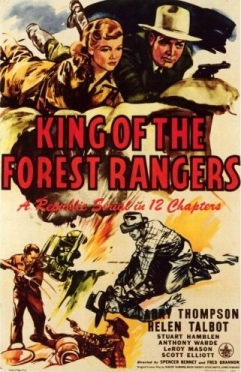
King of the Forest Rangers (1946) is a Republic film serial.

Dangers of the Canadian Mounted is a 1948 Northern Republic film serial.
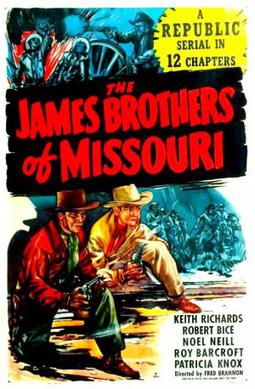
The James Brothers of Missouri is a 1949 American Republic Western film serial.

Desperadoes of the West (1950) is a 12-chapter Republic film serial.

King of the Carnival is a 1955 Republic movie serial that contains a substantial amount of stock footage from the earlier Republic serial Daredevils of the Red Circle. It is the 66th and final serial produced by Republic and is often considered to be among the studio's worst. The plot concerns treasury agents investigating a Cold War counterfeiting operation believed to be connected to a circus.














